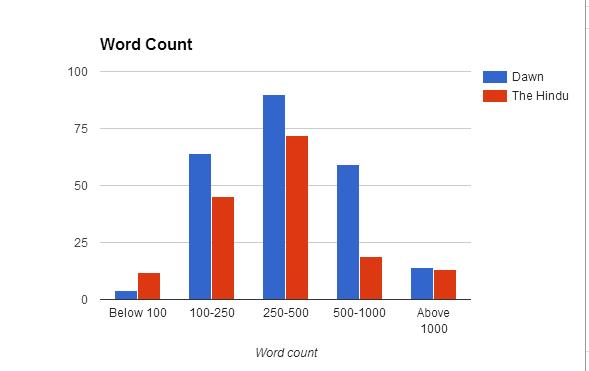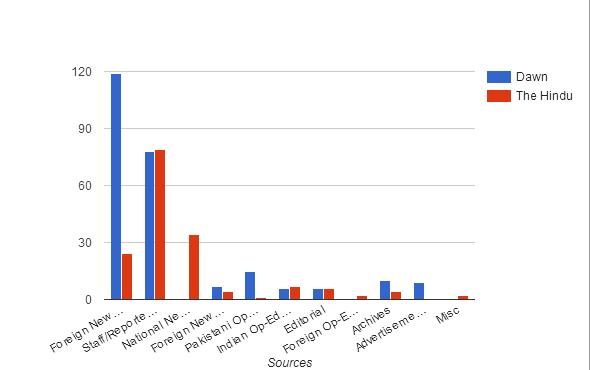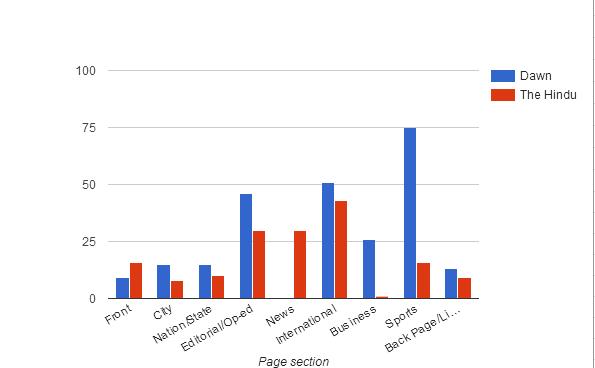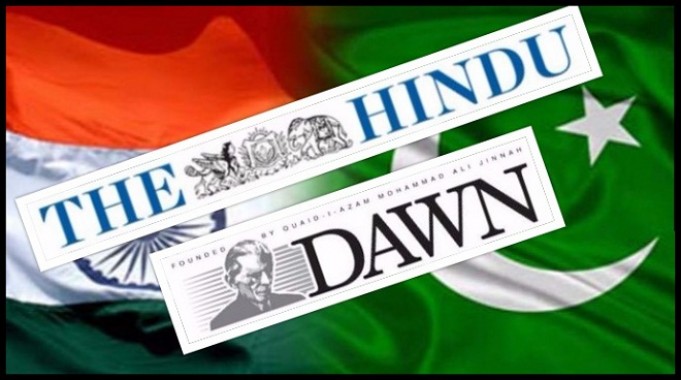How Pakistan’s Dawn covers India
It is generally believed that greater exposure to each other should promote the cause of peace in India and Pakistan. While we mostly expect governments to facilitate people-to-people contacts and exchange of information, it is important to assess the role of non-government sources such as the news media.
I compared the coverage of India in Dawn (Islamabad edition) and Pakistan in The Hindu (Delhi edition) during the period May 01 - May 31, 2016. Dawn has a Delhi correspondent and The Hindu used to have an Islamabad correspondent. Both these newspapers are known to be liberal and, as such, are not representative of the news media, particularly the hawkish television news channels, in their respective countries.[i]
All sections of these two papers, except advertisements, letters to editor, special pages and supplements were scrutinized. Advertisements of Indian movies on the Islamabad pages of Dawn and the sections “From the archives” of The Hindu and “From the past pages” of Dawn were included in the comparison. The exercise revealed fascinating differences between the papers which, in turn, provides glimpses of the way Indians and Pakistanis see each other.
1. Dawn published more news items, editorials, and opinion pieces on India than The Hindu on Pakistan. The former carried 250 items on India in comparison to 163 on Pakistan in The Hindu. If we exclude IPL-related news, Dawn published 210 items on India compared to 163 items on Pakistan in The Hindu.
2. On an average, Dawn carried eight news items per day on India, while The Hindu published about five a day on Pakistan. There is no correlation between the number of India-related news items published in Dawn on a given day and the number of news items on Pakistan published in The Hindu on the same day. Only on six days of the month did The Hindu carry more new items on Pakistan than vice versa. There were occasions when The Hindu published only one item on Pakistan, but Dawn never published less than four on India.

Chart 1: Daily coverage in Dawn (on India) and The Hindu (on Pakistan)
3. The front pages of The Hindu contained more references to Pakistan (16 news items) than references to India on Dawn’s front page (9 news items). However, it should be noted that a third of Dawn’s first page is almost always devoted to advertisements.
4. The average length of Dawn's India-related items was more than The Hindu’s Pakistan-related items. The length of most of the items published in The Hindu (44 per cent) and Dawn (36 per cent) was between 250 and 500 words. The Hindu (7 per cent) published more items containing less than 100 words than Dawn (1.6 per cent) while Dawn (29 per cent) published more items containing more than 500 words compared to The Hindu (20 per cent).

Chart 2: Size of items
5. Dawn’s India-related coverage was more likely to be accompanied by photographs. It published 72 photographs, including eight standalone photographs, on India compared to 17 photographs on Pakistan published in The Hindu. If we exclude IPL-related photographs, Dawn published 42 photographs on India.
6. Dawn's news items and opinion pieces were sourced from a larger variety of sources. More than half of the India-related news published in Dawn was sourced from foreign news agencies (119 items) and foreign newspapers (7 items) including The Daily Star/Bangladesh (1), The Statesman (1), The Times of India (3), and The Washington Post (2). The news items borrowed from The Times of India dealt with the Panama leaks, India’s interceptor missiles, and new research on the age of Indus Valley Civilisation, whereas one borrowed from the Washington Post dealt with casteism on social media.

Chart 3: Sources of News on India or Pakistan
Dawn published opinion pieces borrowed from The Statesman (“Re-imagining Asia” by Salman Haidar) and The Daily Star (“Bangladeshi militants' external connections” by Ali Riaz) on its international page. The newspaper also borrowed the review of “The Man Who Knew Infinity”, a film about pioneering Indian mathematician Ramanujan, from The Washington Post.
One news item published in Dawn referred to The Hindu (“Indian army denies mutiny claim,” May 13) and another referred to a news broadcast on CNN News18 about a Pakistani Hindu refugee in India. In contrast, The Hindu used only 24 items sourced from foreign agencies and four items from The New York Times News Service.
7. Dawn published more items on India that were directly about India than items in which India was mentioned in some other context. The proportion of direct news on Pakistan in The Hindu was only 40 per cent while direct news accounted for 70 per cent of coverage of India in Dawn. Nine items published in Dawn can be classified as miscellaneous (cinema advertisements and seminar announcements), whereas there were no such items in The Hindu. Interestingly, both big budget movies such as Azhar and Baaghi as well as a little known Punjabi movie Kaptaan were advertised in the Islamabad section of Dawn.

Chart 4: All News / Direct coverage of the two countries
8. Dawn covered a much wider range of issues related to India than The Hindu did with Pakistan-related issues. About half the coverage in Dawn was related to sports (29 per cent), art and culture (8 per cent), and business (12 per cent), whereas half the coverage in The Hindu was related to defence and foreign policy. (Even if we exclude IPL news, the share of defence and foreign policy-related news in Dawn’s coverage of India increases to 32 per cent from 27 per cent.). This is contrary to the common perception that Pakistanis are more likely to be obsessed about national security. At least, Dawn’s editors think otherwise and provide more diversity in India-related coverage on its pages.
9. There were 31 business news items in Dawn compared to only three, including one from the archives, in The Hindu. Similarly, Dawn published 20 items (including five movie advertisements) related to art and culture compared to seven such items in The Hindu. Interestingly, 39 per cent of the business news related to India in Dawn was about the cotton market, but this issue was not covered by The Hindu.

Chart 5: Distribution of news across pages
10. In The Hindu, terrorism (43 per cent) and US policy toward Pakistan (17 per cent) were major concerns under the category of defence and foreign policy. In Dawn, Jammu & Kashmir (26 per cent), nuclear weapons, ballistic missiles, and the membership of the Nuclear Suppliers Group (23 per cent) were the main focus of defence and foreign policy in the context of India.
11. Even though the Pakistani government accuses India of promoting terrorism in Pakistan, Dawn carried only one item on this in May and that too as a minor point in an opinion piece written by a former Pakistani ambassador. Similarly, while the Indian government claims that Pakistan occupied Kashmir (PoK) is a part of Jammu & Kashmir, there was no news on PoK in The Hindu, except indirect references in news about terror attacks in Jammu & Kashmir.
12. Despite regular concerns expressed by Pakistan on human rights violations in Jammu & Kashmir, there was no news in Dawn on this subject. On four successive days, Dawn’s event announcement section carried information about a seminar on “Human rights, youth and the issues of Jammu & Kashmir,” but there was no follow up news. Dawn published 14 items related to Jammu & Kashmir including four entries in the section “From the past pages,” one photo published under the newsmaker category, and three news items about militants.
Interestingly, for Dawn, Jammu & Kashmir seems to be limited to the Kashmir Valley as there was no news on Jammu. Both The Hindu and Dawn covered the spat between India and Pakistan on India’s geospatial bill. Dawn also published an opinion piece which suggested that “The draft of bill is another attempt by India to absorb J&K.”
13. The problems of ordinary people divided by the border were given limited coverage. Dawn published a story of a fisherman in the context of the India-Pakistan relationship and The Hindu published an opinion piece on the troubles faced by fishermen and a story on the detention of Pakistani fishermen in India. Apart from this The Hindu also published a news item on the initiatives taken by the Indian Government such as the distribution of devices to alert fishermen about the international maritime boundary. Both newspapers highlighted the humanitarian aspects of the problem.
Similarly, there was a news item on a Pakistani Hindu refugee girl in Dawn who appealed to Indian Foreign Minister Sushma Swaraj for help with college admission. Dawn mentioned multiple attacks for the girl and her family’s migration, while The Hindu noted that the family wanted to migrate to India for a better future.
14. The two newspapers tend to see each other in isolation from the larger South Asian region. There was no news on the SAARC. One item in Dawn dealt with the cancelation of the Nepali President’s visit to India and three others mentioned India in the context of Afghanistan. Dawn mentioned India in four news items on Bangladesh. It suggested that the execution of war criminals is against a 1974 agreement between India, Pakistan and Bangladesh.
A news story about protests against Bangladesh in Pakistan noted the protestors’ claim that the Bangladesh government was acting under Indian pressure. Another item on Bangladesh explored the relationship between Abdul Karim Tunda, an Indian citizen and alleged operative of Lashkar-e-Taiba, and Abdur Rahman of the Jamaat-ul Mujahideen.
The Hindu mentioned Pakistan in five news items on court cases in Bangladesh related to the 1971 War and noted the war of words between Pakistan and Bangladesh on the execution of war criminals. An editorial in The Hindu mentioned Pakistan in the historical background to the current problems. Pakistan figured in two items related to art and culture on Sri Lanka. The Hindu also noted the Pakistani contribution to disaster relief in Sri Lanka. In addition, The Hindu mentioned Pakistan in numerous items on Afghanistan and Taliban.
15. Editorial/op-ed pages include cartoons and news from archives in addition to opinion pieces and editorials. The Hindu published four news items from its archives related to Pakistan and one cartoon on Narendra Modi’s Iran visit in which Pakistan was mentioned along with other countries, while Dawn published 10 items related to India from its archives including two cartoons.

Chart 6: Source of editorial and opinion pieces
On May 27, The Hindu (“India normalises trade with Pakistan”) and Dawn (“India lifts trade ban”) published related news from their archives. These news items covered the restoration of trade links between the two countries after the Tashkent Agreement. Interestingly, the title of the news in Dawn suggested that India had imposed a ban, whereas the title of the related news in The Hindu simply talked about the normalisation of trade relations.
16. Dawn published six editorials and 30 opinion pieces related to India, compared to six editorials and 19 opinion pieces related to Pakistan in The Hindu. One fifth of Dawn's opinion pieces on India were written by Indians, compared to only one opinion piece by a Pakistani in The Hindu. As mentioned above, Dawn also published two opinion pieces related to India on its international page, which were borrowed from Indian and Bangladeshi newspapers.
17. Jawed Naqvi, Dawn’s correspondent in Delhi, wrote five op-eds and three news items during the month. One of his opinion pieces was on the video of Gurmehar Kaur, the daughter of an Indian soldier martyred in Kargil. The Hindu published an opinion piece “What makes a video go viral” on the same video. Dawn’s coverage focused on the core message of the video “Pakistan did not kill my dad, war killed him,” while the opinion piece in The Hindu examined the determinants of public approval of such videos.
18. Dawn has more diversity of India-related opinions, judged from the nationality of op-ed writers, than Pakistan-related opinions published in The Hindu. Moreover, opinion pieces in The Hindu talked about Pakistan in the context of terrorism, Afghanistan, China, Bangladesh and USA, but never as a country deserving independent attention. On the other hand, opinion pieces in Dawn specifically discussed India’s politics, elections, media, performance of government, and defence and foreign policy.
19. Dawn's coverage of strategic developments related to India hinted at the divide between the civilian and military thinking in Pakistan. It published four new items and two opinion pieces on Modi’s Iran visit Chabahar, which noted that Chinese involvement in Gwadar had prompted faster movement on Chabahar. Former army officers quoted in the paper viewed the trilateral agreement among India, Iran, and Afghanistan as a security threat to Pakistan.
In contrast, the opinion pieces in Dawn were critical of the Pakistani approach and compared Modi’s successful Iran visit with Nawaz Sharif’s lacklustre visit to Tehran and how the Iranian President’s Islamabad visit was marred by irresponsible tweets by the Pakistani Army. Zarrar Khuhro's “Strategic Liabilities”(May 30) noted that "While India walked away with gains, we get retweets." He questioned Pakistan’s policy of denying India access to Afghanistan which has pushed India to seek an alternative route through Iran. He also contrasted India's humanitarian intervention in Afghanistan with Pakistan’s backing of the Taliban. Khurram Husain's “Regional Plans” (May 26) called for a non-zero sum foreign policy that promoted regional integration.
The Hindu published three new items, three opinion pieces, two editorials and a cartoon on Modi’s Iran visit Chabahar in which Pakistan was mentioned. One news item quoted US officials who suggested that “the Iranians can put some people in the Pakistani embassy here, as a first step” toward possible normalization of diplomatic relations. Another news item noted the competition between AIR’s Persian service and BBC, China Radio International, and Radio Pakistan.
Srinath Raghavan’s “The takeaway from Tehran”(May 26) and Rakesh Sood’s “Watch the follow through” (May 27) observed that Chabahar will in principle allow India to bypass Pakistan to reach Afghanistan and stressed the importance of implementing the agreements in a time bound manner. Raghavan also argued that, despite the euphoria, India still lacked a strategic approach to Iran. An editorial, “Raising the stakes with Chabahar”(May 25) made similar observations and also compared Indian investment in Chabahar with Chinese investment in Gwadar.
So what’s the conclusion to be drawn from this comparison? It is that neither newspaper adopted a hawkish approach on any issue. Yet, compared to The Hindu’s coverage of Pakistan, Dawn provided greater and more diverse coverage of India. Dawn carried more news items and opinion pieces on India, which covered a very wide range of issues and were drawn from a larger variety of sources.
While this analysis is based only on The Hindu, the conclusion will not change much even if we look at other Indian newspapers. It seems Indians are losing interest in Pakistan. They have given up hope and not very keen to know about Pakistan unless something bad happens. Fewer Indians travel to Pakistan than Pakistanis travel to India.
Indians and Pakistanis visit each other’s countries for meeting relatives and pilgrimage. In addition, Pakistanis come to India for medical treatment, to participate in and watch sports matches, and to work in India’s entertainment industry. It seems we are not well-informed about such a crucial neighbour. As Rajiv Dogra, a former Indian Consul General to Pakistan in Karachi said, ’’sadly, therefore, for a people who claim shared ancestry, Indians are strangers to the pulse of Pakistan.”[ii
Details of daily monitoring are available here .
[i]For example, there are differences between the Urdu and English media of Pakistan. Manzoor Turabi observes that Pakistan's Urdu media, which has a larger readership than the English media, "reflects the thinking in the establishment and conservative elements who continue to cast India-Pakistan relations within a two-nation framework . . . However, the English language press portrays views that are liberal and argue for better India-Pakistan relations." (“Portrayal of India in the Urdu Press of Pakistan,” Institute for Defence Studies and Analyses. http://www.idsa.in/pakproject/meeting-310316)
[ii]Dogra, Rajiv (2015), “Reading the India-Pakistan Crystal Ball,” in Surendra Kumar (ed.), India and the World: Through the Eyes of Indian Diplomats, New Delhi: Wisdom Tree, pp. 95-105.
Ankita Pandey is an independent researcher based in Bengaluru.







